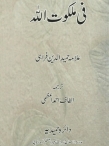
Hamid al-Din Farahi was born in 1863, in the village Phariahah of Azamgarh, UP India. He started his education by committing the Qur’an to memory at the age of ten. He studied Arabic, Urdu and Persian while he was a young boy. He completed his traditional religious education under Shibli Numani (1857-1913), a famous Muslim historian and scholar of the time. Later on, his pursuit of higher studies in Arabic language brought him to Lucknow (1881) and then to Lahore (1882-3). Read More ...
In Lahore, he had the opportunity to remain under the tutelage of Mawlana Fayḍ al-Ḥassan Saharanpuri, an erudite scholar and a great Arabic poet. Farahi joined MAO College Aligarh, to study English language and other disciplines in 1891.
He started his career as a teacher of Arabic language in the Madrasah al-Islam Karachi where he remained for over a decade (1897-1907). During his stay in Karachi (in about 1900) he was appointed an interpreter to Lord Curzon, the British Viceroy to India, during the latter’s diplomatic visit to the Arabian Peninsula. On his return from the tour Farahi joined MAO College Aligarh once again as Professor of Arabic (1907-8), where he came across the German Orientalist, Joseph Horovitz (1874-1931) and learnt Hebrew from him. In reciprocity Joseph Horovitz learnt Arabic from Farahi. Later on Farahi joined, as principal, Dar al-Ulum Haydarabad (1914-19). After a few years he resigned and went back to his home town Azamgarh and devoted his time to developing Madrasah al-Islah (School for Reform). He spent last six years of his life there during which time he was able to train many able students, Islahi being one of them, who would continue studying the Qur’an in the light of the principles introduced by their great teacher. Farahi died on November 12, 1930 in Mithra, India.
A shining star in the comity of the Muslim scholars, Farahi devoted his whole life for the true understanding of the religion of God. He studied the religion from all aspects including its sources, history, epistemology, language, hermeneutics and meaning (hikmah). The most important achievement of which Farahi is credited is his discovery of the principle of Nazm (coherence) in the Book of God. He was able to establish, through a series of works, that contrary to the generally held belief about the lack of coherence in the Qur’an, the Book is perfectly ordered and arranged thematically as well as structurally. In his endeavor to raise the art of Qur’an tafsir to a science with a well-defined methodology he penned down, besides the principles of interpretation prefacing his Qur’an commentary, Nizam al-Qur’an, the following booklets that illustrate these issues further or clarify a relevant discussion that has direct bearing on his understanding of the religion and the religious texts:
- Majmu‘ah-i Tafasir-i Farahi(Collection of Exegeses of Farahi). Translated by Amin Ahsan Islai. Lahore: Faran Foundation, 1991.
- Al-Ra’y al-Ṣahih fīman huwa al-dhabih, A‘zamgarh: Maktabah al-Dairah al-Hamidiyyah, 1968.
- Tafsir Nizam al-Qur’an, Surah al-Baqarah (2), Azamgarh: Maktabah al-Dairah al-Hamidiyyah, 2000.
- Rasail al-Imam Farahifi ‘Ulum al-Qur’an, (Dalail al-Nizam, Al-Takmil fī Usul al-Ta’wil and Asalib al-Qur’an), Azamgarh: Maktabah al-Dairah al-Ḥamidiyyah, 2005.
- Mufradat al-Qur’an(Vocabulary of the Qur’an), Azamgarh: Maktabah al-Dairah al-Ḥamidiyyah, 2004.
- Im‘an fīAqsam al-Qur’an (Study of the Qur’anic Oaths), Azamgarh: Maktabah al-Dairah al-Hamidiyyah, 1930.
- Jamharah al-Balaghah(Manual of Rhetoric), Azamgarh: Maktabah al-Dairah al-Hamidiyyah, 1941.







